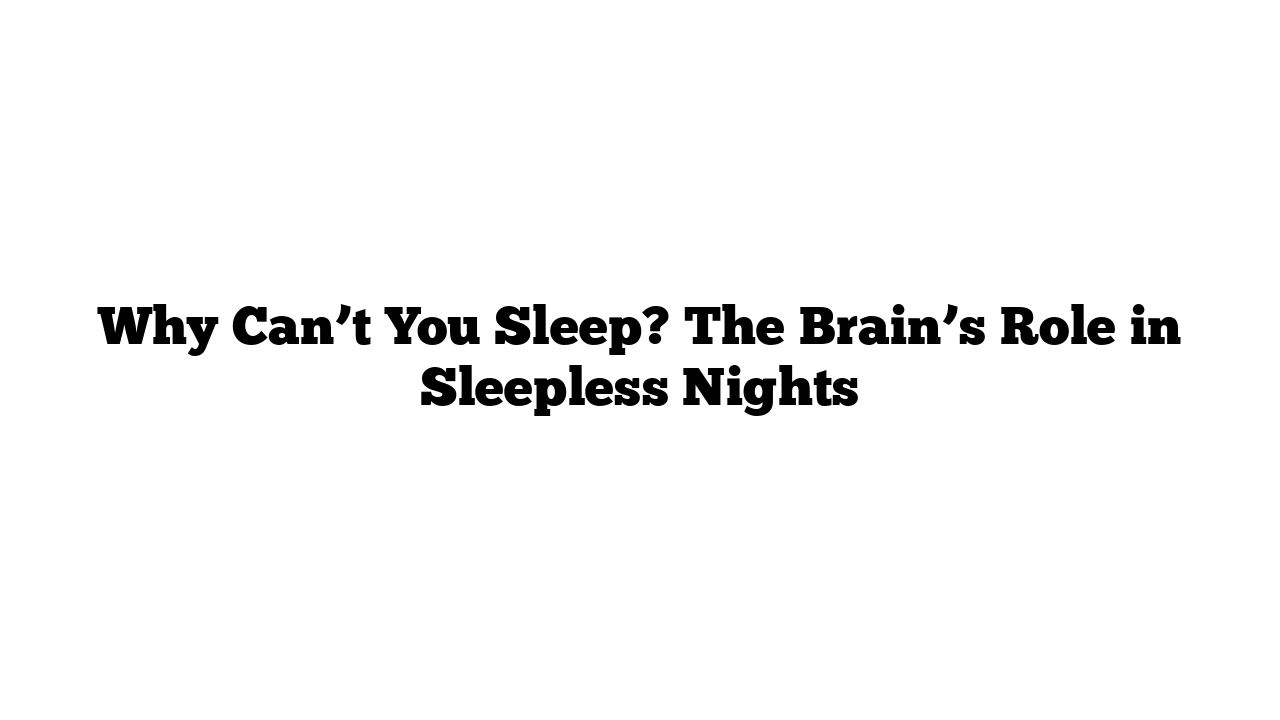It’s 2 A.M., and you’re lying in bed, completely drained, yet your mind is wide awake. Tomorrow’s deadlines, an embarrassing moment from years ago, or the worry of how you’ll function the next day swirl in your thoughts. Does this hit close to home? If so, you’re not alone. Sleepless nights can feel overwhelming, but understanding the brain’s role in this struggle can help you take back control and enjoy peaceful rest.
Let’s explore how your brain works during those restless nights and, more importantly, what you can do to get the sleep you need.
What Controls Sleep: The Brain’s Two Drives
Your ability to fall asleep isn’t just about feeling tired. Sleep is governed by two separate systems in the brain:
- Sleep Drive: This is like the brake on a car. Your sleep drive builds up throughout the day, driven by a chemical called adenosine. As your neurons work, they produce adenosine as a waste product. The more adenosine that accumulates, the sleepier you feel. That’s why after a long day, you may feel a strong urge to nap.
- Wake Drive: Acting like the accelerator, this system keeps you alert. It’s controlled by the lateral hypothalamus in your brain, which produces orexin, a natural stimulant. Orexin triggers wake-promoting chemicals like norepinephrine, acetylcholine, and histamine—the same histamine that makes allergy medications cause drowsiness when blocked.
Normally, these two systems synchronize with your circadian rhythm, your body’s internal 24-hour clock. However, various factors can disrupt this balance, leading to sleepless nights.
Why Can’t You Sleep? Hyperarousal Explained
One major disruptor is hyperarousal, a state where your brain remains on high alert. This can happen when:
- You worry about a presentation.
- You replay past events.
- Your mind won’t stop racing.
Here’s what happens in your brain:
- The amygdala, your brain’s emotional processing center, flags these thoughts as threats.
- This activates the HPA axis (hypothalamic-pituitary-adrenal axis), releasing stress hormones like cortisol and adrenaline. These hormones increase your heart rate and body temperature, signaling your wake drive to stay active.
Hyperarousal is your brain’s way of saying, “Stay alert—there’s danger!” even when the “danger” is tomorrow’s meeting.
The Second-Wind Phenomenon
Have you ever pushed through sleepiness to finish a project or binge-watch a series, only to feel suddenly wide awake? This is the second-wind phenomenon.
Ignoring your natural sleep drive signals your brain that you need to stay awake. This triggers a release of wake-promoting chemicals, like cortisol and orexin, giving you a burst of energy. While this might have been essential for survival in ancient times (think watching for predators), it works against us in today’s world.
Modern Technology and Sleeplessness
Our devices don’t just emit blue light that suppresses melatonin (the sleep hormone). They also keep our brains engaged with constant streams of information. Every email, notification, or scroll through social media triggers your brain’s reward system, releasing dopamine. This keeps your brain wired and overrides natural sleep signals.
The Vicious Cycle of Sleep Anxiety
Bad sleep nights can create a feedback loop of anxiety:
- You associate your bed with frustration and sleeplessness.
- This triggers your stress response, releasing cortisol and activating your fight-or-flight system.
- This arousal makes falling asleep even harder, confirming your fears and worsening the cycle.
Breaking this loop requires retraining your brain’s associations with sleep.
Brain-Based Solutions for Better Sleep
1. Work With Your Natural Rhythms
Your sleep drive peaks about 14–16 hours after you wake up. Catch that evening wave of sleepiness to avoid triggering the second wind.
2. Embrace Paradoxical Intention
Instead of forcing sleep, try paradoxical intention: tell yourself to stay awake while doing something boring. This reduces performance anxiety and often helps you drift off naturally.
3. Activate Your Relaxation System
Deep breathing can lower stress and calm your brain. Try box breathing:
- Inhale for 4 seconds.
- Hold for 4 seconds.
- Exhale for 4 seconds.
- Hold for 4 seconds.
This technique activates your parasympathetic nervous system, promoting relaxation.
4. Limit Technology Use Before Bed
Reduce screen time at least an hour before bed. Opt for calming activities like reading or meditating to prepare your brain for rest.
When to Seek Professional Help
If sleeplessness becomes chronic (three nights per week for three months), it’s time to consult a healthcare provider. Signs of chronic insomnia include:
- Taking over 30 minutes to fall asleep regularly.
- Waking up multiple times during the night.
- Feeling unrefreshed despite sufficient time in bed.
Treatments like Cognitive Behavioral Therapy for Insomnia (CBT-I) can help retrain your brain’s sleep associations and manage anxiety.
A Balanced Brain for Better Sleep
Getting quality sleep isn’t just about feeling tired—it’s about understanding your brain’s complex sleep-wake systems and working with them. Occasional sleepless nights are normal, but consistent issues should be addressed to protect your mental health and resilience.
Reference Websites:
Top 10 FAQs About Sleeplessness
1. What are the main causes of insomnia?
Stress, anxiety, poor sleep habits, and medical conditions are common causes.
2. How does blue light affect sleep?
Blue light suppresses melatonin, delaying sleep onset.
3. What is hyperarousal?
A state where the brain remains alert, often due to stress or anxiety.
4. How can I break the second-wind phenomenon?
Follow your natural sleep drive and avoid overstimulation in the evening.
5. Are sleep aids effective?
Short-term use can help, but long-term solutions involve addressing underlying issues.
6. What is CBT-I?
Cognitive Behavioral Therapy for Insomnia is a treatment targeting behaviors and thoughts affecting sleep.
7. How can I reduce sleep anxiety?
Practice relaxation techniques and build a calming bedtime routine.
8. Does caffeine affect sleep?
Yes, caffeine blocks adenosine, delaying sleepiness.
9. Can exercise improve sleep?
Regular exercise promotes better sleep but avoid intense workouts close to bedtime.
10. When should I see a doctor for sleep problems?
If sleep issues persist for over three months and impact daily life, consult a specialist.
